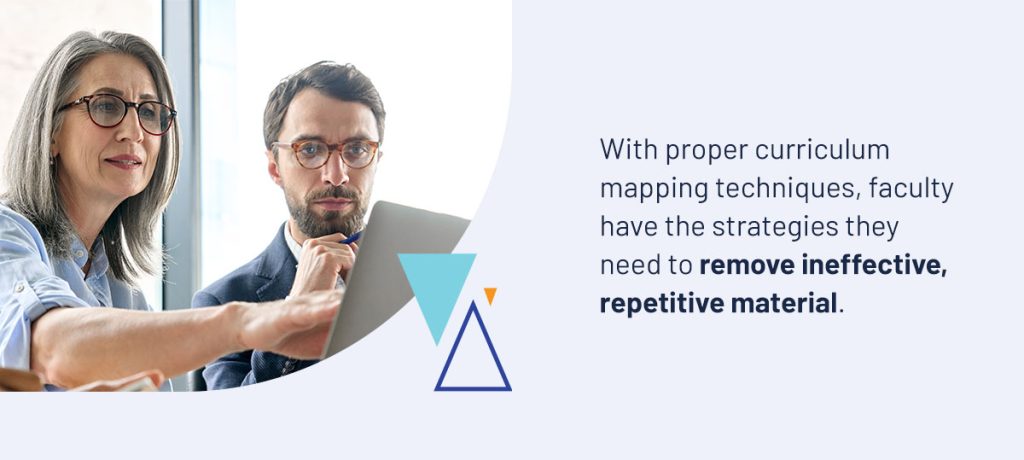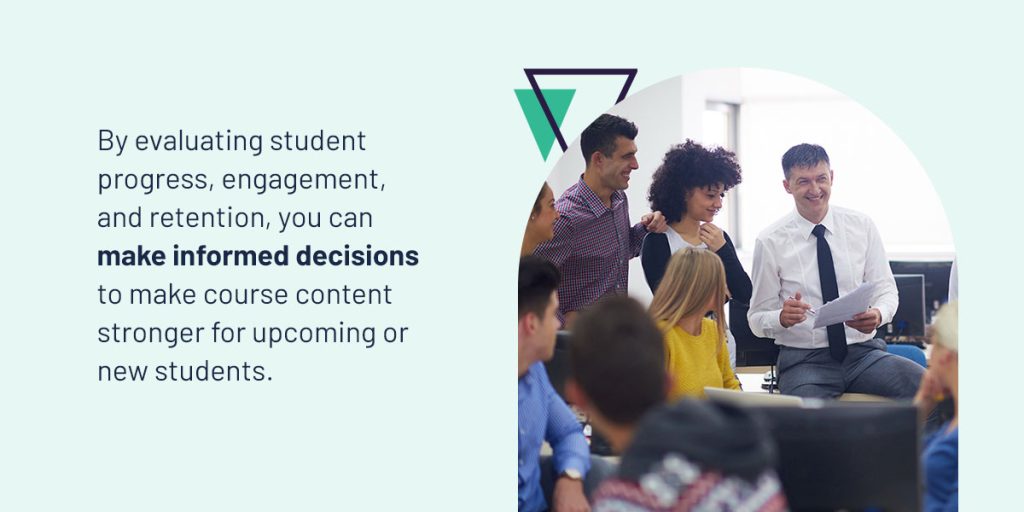
How well do the students at your school learn? This is often the million-dollar question for administrators at colleges, as the goal of any educational institution is to foster learning. There’s always room for colleges to grow to meet student needs, especially when it comes to curriculum. Fortunately, curriculum mapping can help — and it can even ensure faculty become more well-equipped in their roles.
Continue reading to learn more about how improving student curriculum through curriculum mapping can benefit both faculty and students.
What is curriculum mapping?
A curriculum should meet academic expectations to keep students on track so they’re prepared for the future. Curriculum mapping is the process of assessing curriculum data to maintain a record of what students are learning and when they’re learning it.
Curriculum maps can help educators identify potential curriculum issues, such as gaps and repetition. Using curriculum mapping to find areas for improvement guarantees that students aren’t learning certain information too soon or too late. This approach also ensures students gain new knowledge, which they can use as building blocks as they advance to higher-level courses. Without curriculum mapping, educators may find themselves inadvertently teaching their students subjects they already know or topics that are too upper-level for them.
Using a curriculum map to help students learn more
Developing a curriculum improvement plan starts with curriculum mapping. Here are seven key aspects of curriculum mapping that highlight how you can leverage this strategy to help students learn more and get the most from their time at your institution.
1. Allows for enhanced collaboration
Today, curriculum mapping takes place digitally, so professors who use curriculum mapping in the same departments can access each other’s plans. If two instructors teach the same course, they can work together to ensure students in both classes will come away with similar knowledge. Alternatively, faculty who teach more advanced courses can check that their lesson plans won’t introduce unfamiliar content.
This approach helps encourage faculty to grow in their roles, too. Rather than sticking to the same curriculum each year, instructors meet the challenge of reflecting on how they can adjust their courses. In a setting like higher education, where innovation is constantly happening, preparing to adapt for change is a crucial skill.
Ultimately, curriculum mapping is an effective way to encourage faculty to work with one another and develop newfound abilities as they map out their courses. This enhanced collaboration helps students learn more by building on their previous knowledge and ensuring their content connects throughout their educational journey.
2. Makes accessing resources simpler
Because curriculum mapping is inherently collaborative, faculty can build a plethora of resources as they create their respective lesson plans. If a professor is interested in screening a film, they can look through each professor’s past curriculum maps to identify an appropriate option. This selection of resources helps instructors avoid repeating learning activities while drawing inspiration from past ideas.
Curriculum mapping creates a centralized hub of resources that live within your school. Rather than professors keeping personal lesson plans, faculty will share their curriculum maps through the cloud, meaning they exist forever. If an instructor moves on to another higher learning institution, colleagues won’t have to do any guesswork — that instructor’s strategies are still available to them. This aids in enhancing student learning as educators can continue providing quality instruction without worrying about possible disruption during times of change, providing a level of stability for students that allows them to flourish on their current path.
3. Helps faculty reach benchmarks
A curriculum map is crucial for identifying where instructors can improve their courses. If an instructor maps their current curriculum and notices they’re teaching a concept their students have yet to learn, they can quickly revise the lesson to ensure it matches their course level. As a result, the educator will likely notice an improvement in learning outcomes, such as higher engagement in the classroom.
Curriculum mapping ensures faculty uses time wisely by avoiding giving repeat lectures or administering familiar content. After students pass an introductory course, they’ll usually move on to a higher-level class that expands on the concepts they’ve already learned. If a professor spends a lot of time reviewing old information, students may become dissatisfied with the time and money they’re putting toward your institution and their education.
The curriculum mapping process helps prevent these adverse outcomes by ensuring each course delivers new and valuable information. Because curriculum mapping is a collaborative process amongst faculty, they can work together to create lesson plans that help their students learn as much as possible.
4. Ensures students remain engaged
When it comes to choosing where to attend college, students make their decisions based on numerous factors, such as finances, degree programs, size, and more. Another key variable is the kinds of classes they’ll be taking to pursue their intended path. As students review sample courses during orientation, they want to see a plethora of courses that teach them what they need to know and nourish their passion for learning.
Without curriculum mapping, students may end up in courses that negatively impact their college experience. If a student is in an introductory course that feels too advanced, they’ll likely quickly become discouraged from that subject, which may influence their decision to stay on a given degree path. When numerous students are frustrated because professors are testing them on information they’ve never learned, they may even begin to feel as though college isn’t right for them.

Maintaining high student engagement levels directly reflects on your higher education institution’s retention rates. With proper curriculum mapping techniques, faculty have the strategies they need to remove ineffective, repetitive material. As a result, students will be in classes that fit their current knowledge levels, helping them remain satisfied and committed through their college experience.
5. Aligns instruction pace with activities
Along with creating a cohesive path within a degree or program, a curriculum map empowers instructors to align their course content with classroom activities, assignments, and other learning opportunities. An educator may have several activities they think will be valuable for students to complete, but it’s crucial that the student learning pace aligns with these tasks.
For example, a science-related course may use lab activities to support learning. If an instructor aims for students to complete one lab each week for the duration of the semester or course period, they can use a curriculum map to ensure this timeline is supportive. Instructors will be able to take a close look at important dates and other factors that could impact the learning pace. For instance, a holiday break may make it challenging to complete a lecture and lab activity within one week, highlighting an area where an instructor may need to reconsider that week’s lesson plan to avoid rushing through lectures or prompting students to complete an activity without enough time to learn and prepare.
6. Provides opportunities for informed redesigns

The curriculum mapping process is one that you will revisit time and time again to find new opportunities for growth and improvement. By evaluating student progress, engagement, and retention, you can make informed decisions to make course content stronger for upcoming or new students. Educators can evaluate modules that were more challenging for students or opportunities to implement new activities or content to keep students engaged. Using student feedback and data, you and your faculty can build a program that directly reflects student needs, creating an environment of continuous improvement to drive student success and engagement.
7. Ensuring consistency
Another aspect of curriculum that can improve student success and help them learn more is consistency across several domains. Consistency in the classroom, throughout a program, and among instructors can create a more seamless and enjoyable learning experience. Students can feel confident that they’re gaining the same skills and knowledge as other students in a similar class with a different instructor or feel confident having different educators as they progress on their educational journey, knowing their educators collaborate to build course content.
Streamline your curriculum with Watermark
Introducing curriculum mapping in your higher education institution will take both time and effort. Watermark can help your faculty take charge of the curriculum mapping process with a comprehensive platform.
Watermark Curriculum Strategy allows educators to collaborate with one another while creating accessible curriculum maps. There’s no need for instructors to store their curriculum plans in folders or on hard drives. Through the Watermark platform, they can upload their lesson plans, resources, activities, and more so that colleagues can compare curriculum maps. As a result, you can build entire course catalogs and handbooks that outline each course you offer at your college.
Interested in learning more? Sign up for a demo today to get started.















































































































































































































































































































































































































